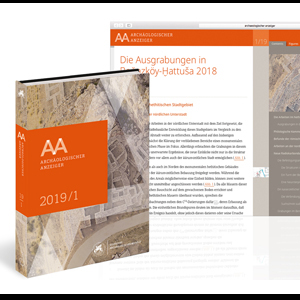Together with the German Archaeological Institute, we have completely rethought a traditional journal and developed it into a modern scientific publication.
The “Archäologische Anzeiger” (AA) is one of the significant journals in the field of archaeology, published by the German Archaeological Institute since 1889. Nowadays a large amount of archaeological work is digital and networking data plays a big role. Scientific publishing also means to work with different formats and serve different media, to reach a growing readership and enlarge a scientific network. After an extensive analysis the solution became certain: the content of the AA should be published in two media simultaneously. Whereas the printed book serves as a scientific reference work, the digital version forms the basis for further modern research. To clarify the identity of both publications, the design needed to work cross-media, be esthetic and functional. They should be recognized as a family and still visualize an individual character. The valence of the book was stressed by a generous, colourful and open design – still a “must-have” on the shelfs of the target group. On the other hand the web-application was intended to work intuitive, appealing and functional, to prove high usability within its scientific community.The Process
For the first time in the DAI publishing history scientific publishing has been taken further by producing two formats out of one source: a printed book and a web-application. Each of these formats incorporate an extensive production process. Books are being written, edited, layout and made ready for print. For web-applications content has to be written, layouts designed and programmed. In both formats there are limits for specific content. For example books cannot display films. The visualization of exact colours on digital devices is limited. Therefore both formats compliment each other for an excellent communication in scientific research. In order to combine both production processes, the content was recorded for both media from the beginning. Authors had to collect and tag all images, videos, links or other data for texts. Depending on the identification (tag), it was programmatically defined in which medium the content was placed and displayed. At the same time, we defined the layout formats in InDesign and the specially developed “Journal Viewer”. A coordinated conversion process made it possible to adjust the content for the different “programme languages” and to export it from the layouted book documents into the Journal Viewer. With the new edition of the “Archäologischer Anzeiger”, a prototype has been created that publishes and networks knowledge in a meaningful way.

